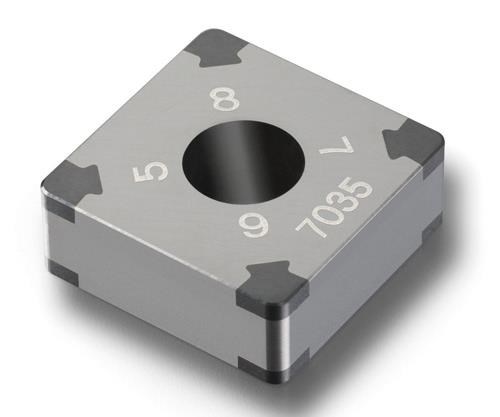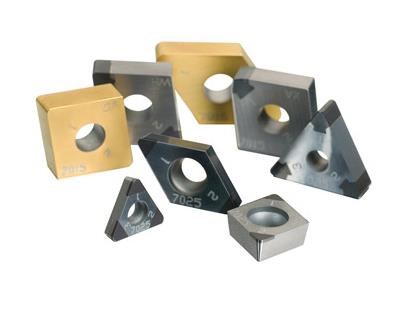Getting the Most Out of Hard Turning
Traditionally, production of most parts made from hard or hardened materials, defined as those at or more than 45 HRc, required dedicated grinding equipment and processes.
Traditionally, production of most parts made from hard or hardened materials, defined as those at or more than 45 HRc, required dedicated grinding equipment and processes. Steady advances in the technology of machine tools and cutting tools have expanded the suitable alternatives available to today’s manufacturers, and an increasing number are exploring their options.
For many applications, hard part turning provides several advantages relative to grinding. In general, turning centers tend to cost less than precision grinders and also provide the obvious benefit of providing a wider range of processes to increase operational flexibility. Tooling inventory is also reduced, and turning centers are more easily integrated into an automation system than grinders.
Additionally, the turning process produces chips that can be recycled rather than swarf that must be disposed of. Grinding still provides an edge for components requiring tolerances in excess of ±0.0002 inch, but hard part turning proves a superior process for most other applications. When a manufacturer decides to reap the benefits of hard part turning, several key areas should receive attention.
Machine Tool Design
The choice of machine tool plays a vital role in successfully undertaking hard part turning. Most machine tool builders currently offer models specifically designed to provide optimal performance for the process. Whether contemplating a new investment or analyzing whether a current asset would be suitable for the task, there are several factors to consider.
The base construction of the machine will significantly influence whether it can maintain the rigidity necessary for the process. A cast iron or cast iron reinforced base will provide the best stability.
Turret construction will also help to determine machine suitability for hard part turning. Ideally, a manufacturer would look to a very rigid turret setup with an integrated modular toolholding system, which helps to minimize vibration by reducing tool overhang. To optimize performance, this integrated toolholding system should incorporate holders that completely surround the tools, as opposed to relying on two center bolts to hold tools in place.
Last, depending upon the specifications of the parts to be machined, it may be prudent to invest in a machine with a tailstock option. For parts that extend from the chuck more than four times their diameter, a tailstock will likely be necessary to maintain the part stability needed to achieve consistent results.
Soft-State Preparation
When considering a hard part turning application, the preparation of the component in its soft state exerts a tremendous influence on overall success. Achieving consistent output requires using consistent input. An even amount of stock should be left on parts prior to hardening. Too often, a shop focuses on the final product and overlooks this key factor.
The resulting variation in depth of cut exposes the tool to very different cutting conditions, which can directly impact quality, tool life and productivity. In hard part turning, removing 0.0008 inch or 0.0012 inch of material will exert different enough forces on the tool to harm overall process stability.
The same holds true for material hardness. A part made from 58 HRc steel will machine differently than one made of 62 HRc. Even if such variation is allowable in the finished parts, it should be avoided for the sake of process efficiency and effectiveness.
Beyond ensuring consistency of material and dimensions across parts in their soft state, manufacturers should also look for ways to alter design in a way that prepares the components for turning once hardened. If possible, any holes, keyways and slots should be chamfered. This reduces stress on the tool and process by providing smooth entrance and exit on interruptions.
Insert Selection
Insert selection constitutes one of the first considerations when tooling up for a hard part turning application. Carbide inserts provide excellent performance in materials of 40 to 50 HRc, making them a suitable option for applications on the lower end of the hard material spectrum.
Common materials in the 50 to 55 HRc range include mild steels with low carbon content. Parts made from these materials are typically case-hardened, requiring tools highly resistant to crater wear. Ceramic inserts provide an excellent choice for these types of applications.
Beyond 55 HRc are materials that include case-hardened and most through-hardened steels, which require extra resistance to flank wear. CBN (cubic boron nitride) excels in both roughing and finishing of these demanding materials. The second hardest material, CBN, offers excellent resistance to wear and the detrimental effects of high cutting temperatures.
With materials harder than 55 HRc, carbon content plays a significant role in determining what type of CBN insert to apply. Materials with high carbon content will be very abrasive, necessitating an insert composition higher in CBN and lower in ceramic binding. This make-up will minimize flank wear on the insert, but requires a slower cutting speed of around 400 sfm to avoid crater wear.
Conversely, flank wear becomes less of an issue with low carbon content materials, allowing for the use of inserts with higher ceramic binding content and a greater resistance to crater wear. This enables the use of higher speeds, typically in the range of 600 sfm.
In addition to material carbon content, part design also influences selection of a CBN insert. For parts with long continuous cuts, a CBN content of around 40 percent will typically be used. With light interrupted cuts, such as holes or keyways that have been chamfered, CBN content of 50 to 60 percent will improve toughness to the needed levels, while still achieving very good wear resistance. With severe interruptions to the cut, 70- to 75-percent CBN content will be necessary to achieve the edge-line toughness required to withstand the demands of the application.
Edge preparation of an insert also impacts the hard part turning process. This involves imparting an angle onto an insert’s cutting edge to alter its performance under various cutting conditions. The width and degree of this angle vary across different edge preparations. A T-Land is the most common of these, using a ground angle to focus and distribute the cutting forces across a specific part of the insert’s edge. An S-Land is similar to a T-Land, but introduces a slight hone on the edges of the insert where the land angle and face of the insert meet, increasing wear resistance. With an E-Land, no grinding is performed, but the insert is produced with a 15- to 20-micron hone, offering protection from fracturing of the edge during cutting.
Last, use of a wiper geometry can increase quality and productivity. In general, when comparing a wiper geometry with a standard nose radius, the wiper will achieve the same surface finish at double the feed rate. Conversely, changing to a wiper geometry and maintaining the same feed rate will result in a much higher surface finish quality. These positive effects result from how wiper geometries spread the cutting forces over a much greater portion of the insert.
Programming Considerations
With OD hard part turning, keeping the tool as close to the centerline of the workpiece as possible is critical, especially with smaller parts. Maintaining positioning within 0.002 inch of centerline will significantly increase part quality. With ID boring, positioning depends upon the amount of tool overhang. It will likely be advantageous to set the boring bar slightly above center, so that cutting forces bring it into center, rather than push it out of the optimal position.
When possible, it is also advisable to position the tool right side up within the machine. This puts cutting pressures back into the bed of the machine, reducing vibration and increasing rigidity within the process to achieve higher quality results.
A programmer must consider whether to implement a one-cut or two-cut strategy with hard part turning. With a high quality machine tool and the appropriate tooling, a single cut will often produce acceptably high levels of shape and surface quality. The most common exception occurs in instances when it is impossible to achieve consistency in the part throughout hardening, either in terms of hardness or shape. In those cases, a two-cut strategy will likely be needed to maintain high quality.
Monitoring Insert Wear
All inserts will eventually demonstrate wear patterns, and monitoring these can provide insight into optimizing the cutting process. When hard turning with ceramic or CBN inserts, crater wear will occur on optimized processes, though if it occurs excessively, there may be a need to reduce speeds or switch to an insert with a lower CBN content and better wear resistance.
Flank wear also commonly appears in hard part turning and typically indicates a need to reduce speeds. If notching of the insert occurs, it will typically take place at the depth of cut. Changing the lead angle of the insert can reduce the effect and help produce thinner chips.
Hard Part Turning on Swiss-Type Machines
While the majority of hard parts turning applications to date involve components for the automotive or general engineering industries, a growing number of shops with Swiss-type machines are using the process for medical parts. These manufacturers face all of the previously mentioned factors, with an additional consideration to take into account.
While CBN inserts can provide excellent finishing performance in such applications, tool life will be heavily dependent upon the type of coolant being used. The majority of Swiss-type machines incorporate oil-based coolant systems, which result in heat being trapped in the cutting zone. With the high temperatures generated by hard part turning, a water-soluble coolant system provides a superior result, boosting tool life and productivity.
The Value of Expertise
Hard part turning offers clear advantages to today’s manufacturers, providing a means to eliminate specialized machinery, increase flexibility and maximize productivity. The preceding issues represent some of the most common faced among those who integrate this process. However, there is no substitute for expertise.
Machine tool builders and cutting tool providers both have large teams of engineers who work regularly with process optimization across a variety of parts. Whether a company is undertaking its first hard part turning application or merely looking to get more out of an existing process, requesting consultation from experts will almost always yield superior
results.
Related Content
The Value of Tool Monitoring on Rotary Transfer Machines
By using a tool monitoring system, shops can save costs associated with machine maintenance and downtime for tool changes while increasing cutting performance.
Read MoreMaking Micro Threads
Production of micro threads can be challenging, but using the most suitable tools for a given application can simplify the task.
Read MoreTool Path Improves Chip Management for Swiss-Type Lathes
This simple change to a Swiss-type turning machine’s tool path can dramatically improve its ability to manage chips.
Read MoreRepeatability and Rigidity Are Key for Quick-Change Swiss Tooling
A rotary wedge clamping system is said to enable this two-piece, modular tooling system for Swiss-types to offer the performance of a solid tool.
Read MoreRead Next
Tooling Up For Hard Turning
Hard turning isn’t hard to do. However, it does require an understanding of the process dynamics and a systematic approach to the tooling involved. This article looks at how proper preparation will deliver consistent, predictable hard-turning results.
Read MoreHard Turning as an Alternative to Grinding
Hard turning can be a cost effective alternative for shops looking to streamline part processing.
Read More5 Aspects of PMTS I Appreciate
The three-day edition of the 2025 Precision Machining Technology Show kicks off at the start of April. I’ll be there, and here are some reasons why.
Read More
























